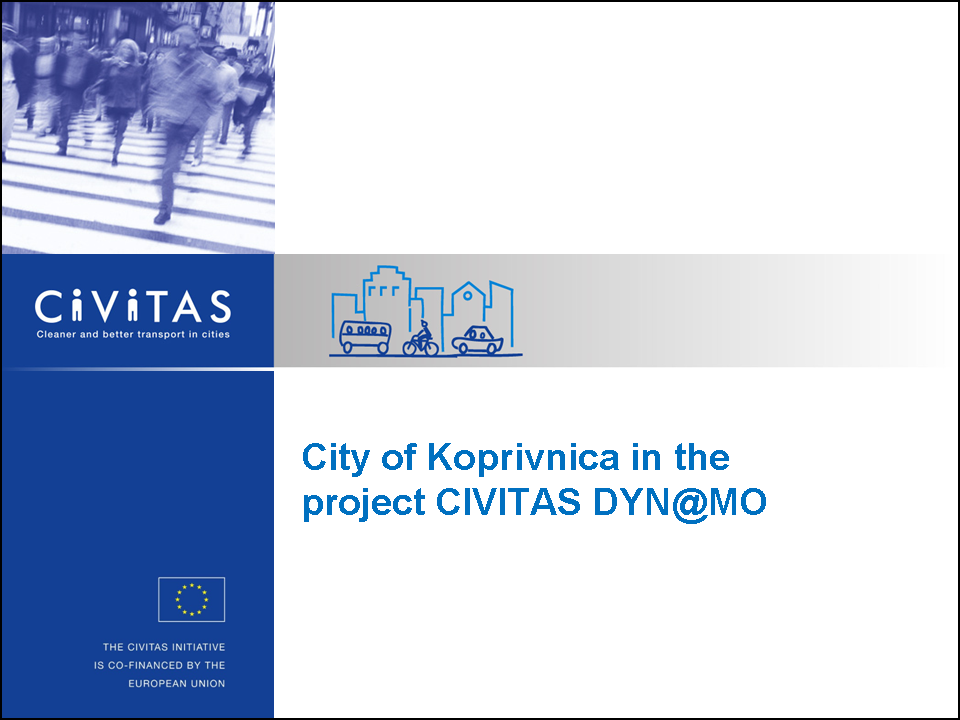
|
|
Din@mični gradovi u akciji za održivi promet
- Uključujemo građane u dinamično planiranje suvremenog gradskog prometa
- Primjenjujemo čista i energetski učinkovita prometna rješenja
- Razvijamo sustave i mjere e-mobilnosti
|
|
|
|
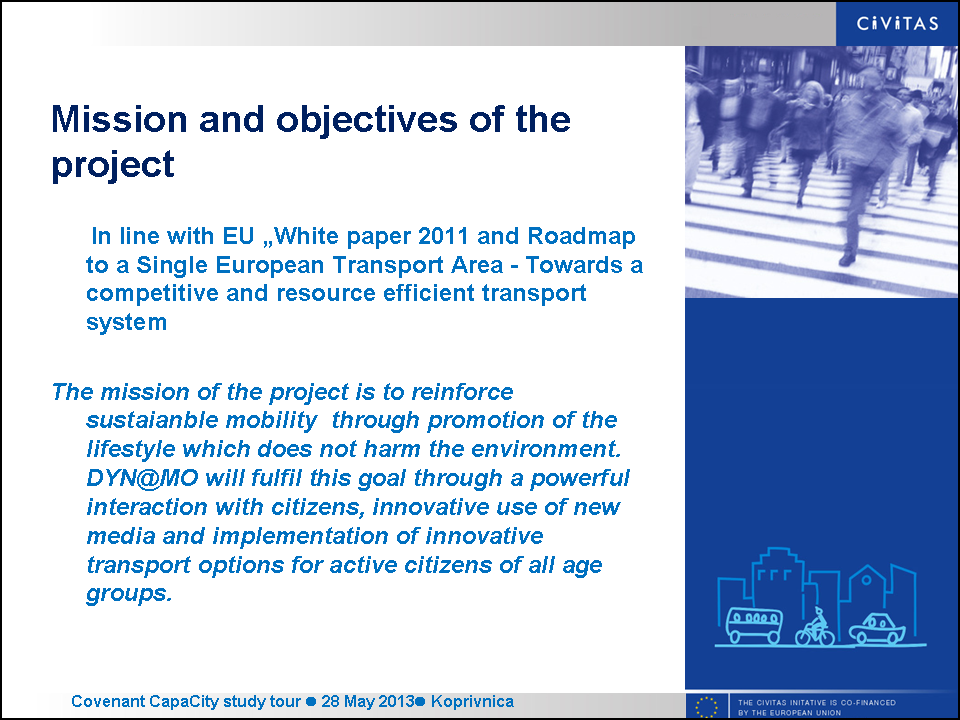
|
|
Koprivnica
Koprivnica is a city of 33,700 inhabitants in north-west Croatia. Internationally recognized for food processing
and pharmaceutical industry as well as Croatian naïve art movement, it is also the educational, cultural
and sports centre of regional importance. It is currently developing a concept of regional university for 5,000
students. Active sustainable mobility policies of the city have resulted in the high percentage of cyclists and
pedestrians in the city centre. The biggest challenge for the city in making the local transport more sustainable
is the lack of public transport.
|
|
|
|
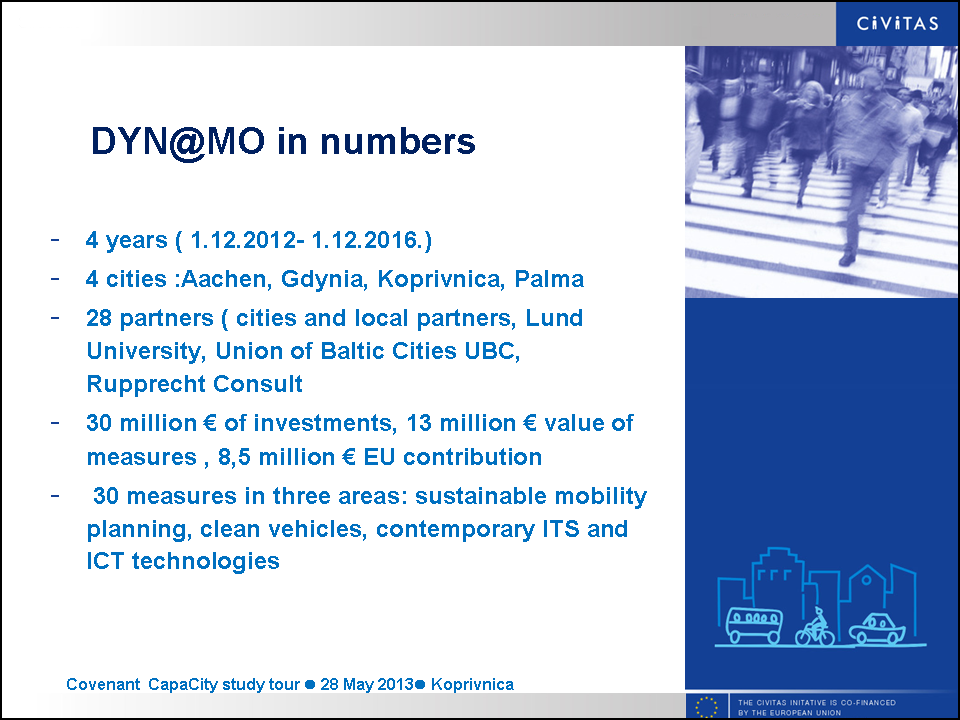
|
|
Transport situation in Koprivnica
Favourable geographical position of the city at the
crossroads of two major European transport corridors
has granted Koprivnica its fast development
in the past. However, the current shape of repair of
both national road infrastructure and railway system is
unsatisfactory. This has resulted in the sharp decline
of the use of public transport based on buses and
trains and consequently the quality of their service.
On the contrast, the city has improved the infrastructure
in the city centre and systematically promoted
cycling and walking. An extensive network
of pedestrian footpaths and cycling tracks, together
with energy-efficient public lighting has contributed
to the attractiveness of sustainable modes of travel. It
resulted in the modal split of almost 40% of trips made
on foot or by bicycle.
Sustainability of freight transport remains an issue,
while the development of public transport inside the
city and in its surroundings is the aim of the CIVITAS
DYN@MO project. Further major improvement involves
the reconstruction of the national railway system
along the Pan-European transport corridor Vb, allowing
for the improvement of regional and local railway
infrastructure.
|
|
|
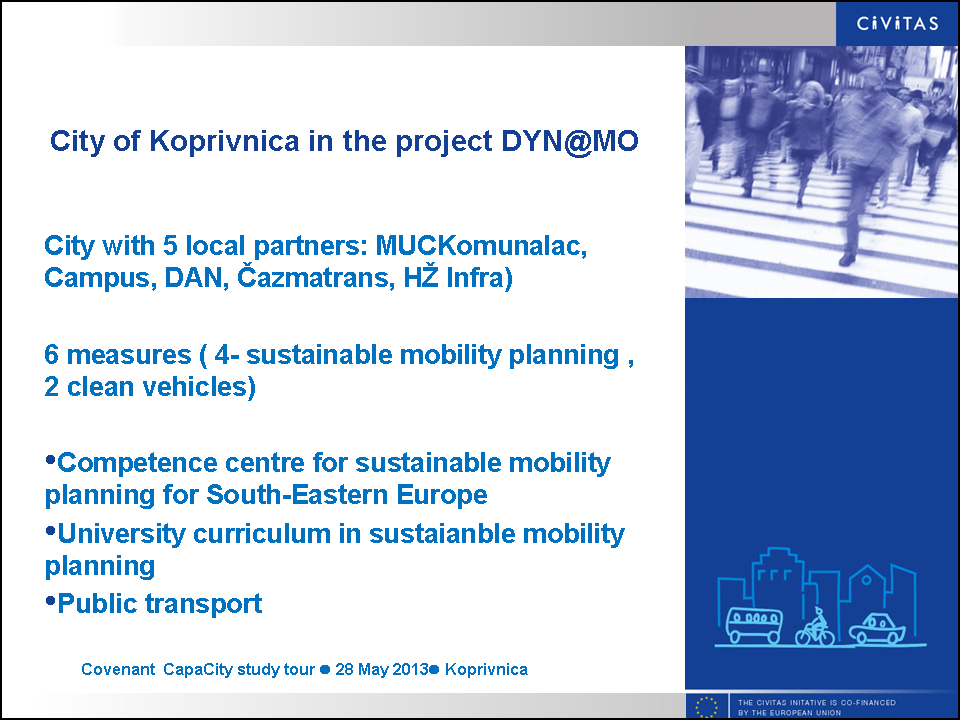
|
|
Planning for sustainable urban
mobility
The city has developed two mobility programmes
called “Town on the Move” and “Streets for People”,
implemented between 2002 and 2009. These
programmes improved mobility infrastructure and
promoted sustainable means, resulting in the high percentage
of almost 40% of cyclists and pedestrians in
the city centre. Incoming and outgoing traffic is much
less sustainable due to the lack of public transport
and the overall popularity of cars for daily transport.
Sustainable mobility has also been a part of the Local
Agenda 21 (LA21), adopted in 2008. Public participation
in the planning process of development of the
LA21 has improved public awareness of sustainable
mobility. The development of the LA21 has been an
important step in the development of planning skills
and raising capacities of the city administration.
Sustainable Energy Action Plan, adopted by city
council in 2011 in the scope of Covenant of Mayors,
includes further measures aimed at reduction of
greenhouse gas emissions.
|
|
|
|
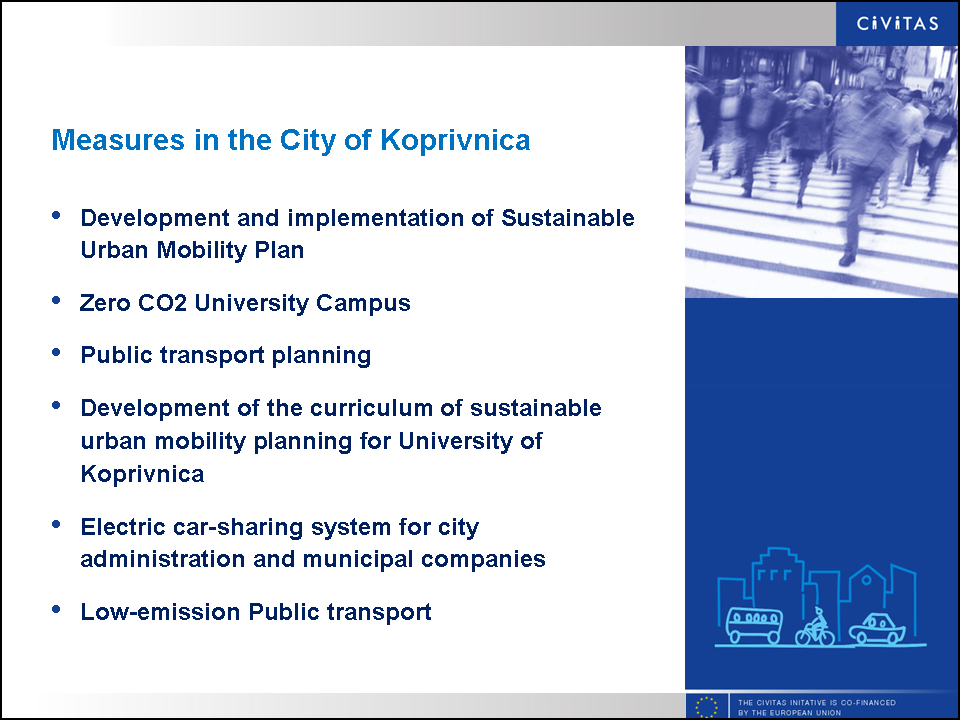
|
|
CIVITAS DYN@MO objectives
and measures in Koprivnica
The development of Sustainable Urban Mobility Plan
and sustainable public transport are the main objectives
of the CIVITAS DYN@MO activities in Koprivnica.
Based on its previous experience, the city perceives
the SUMP process as an important learning experience
to achieving new urban planning expertise and
creating an SUMP competence centre for the wider
region. It will also serve as an example for smaller
cities Europe-wide, facing similar mobility challenges.
CIVITAS DYN@MO will place a strong focus on the
future university students’ mobility needs as the new
university campus is planned to become a model area
of sustainable mobility solutions and a zero emission
zone. A wide range of attractive sustainable mobility
options will be offered and tested in this model area,
in order to reach optimal solutions.
|
|
|
|
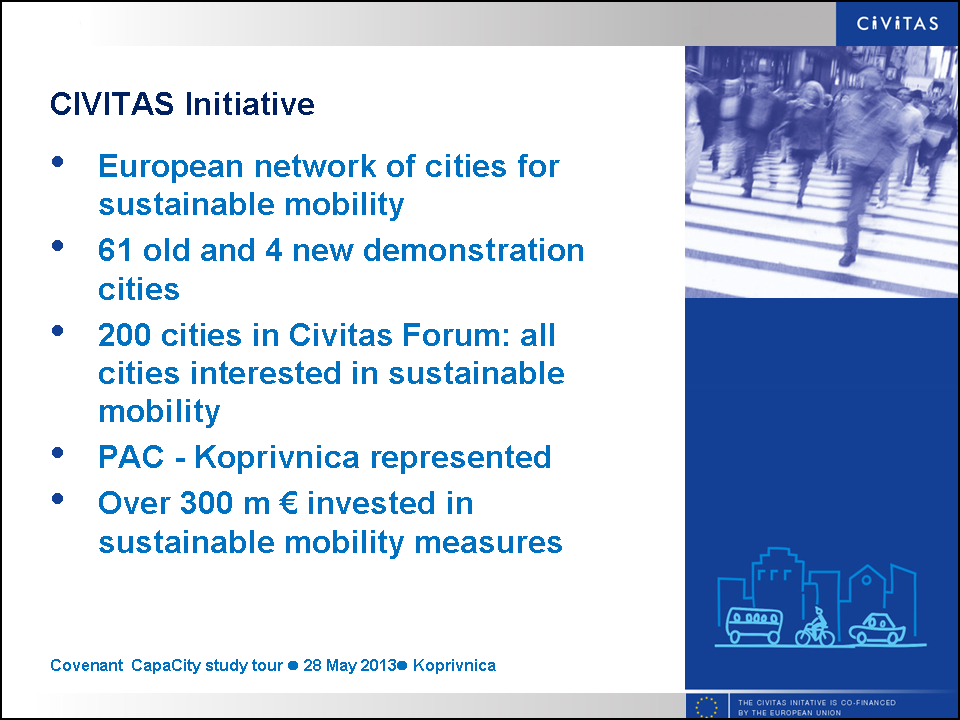
|
|
The progress of measure implementation and acceptance
of new solutions will be actively promoted via
Mobility 2.0 platform, developed by university students
themselves. The first users will record their experience
and motivate the lively interaction with potential target
groups.
An innovation corridor will be established within the
project, including the local railway line connecting the
northern and southern city boundaries as well as the
industrial zone and the future university campus. In
the middle of this line, the integrated public transport
terminal is located serving also as the starting point
for electric buses to be used for public transport. The
initial public transport scheme will connect the city
to its catchment area and reduce the use of cars for
daily commuting. Electromobility will also be promoted
through a car-sharing scheme for the local administration
and municipal companies based on electric
vehicles.
|
|
|
|
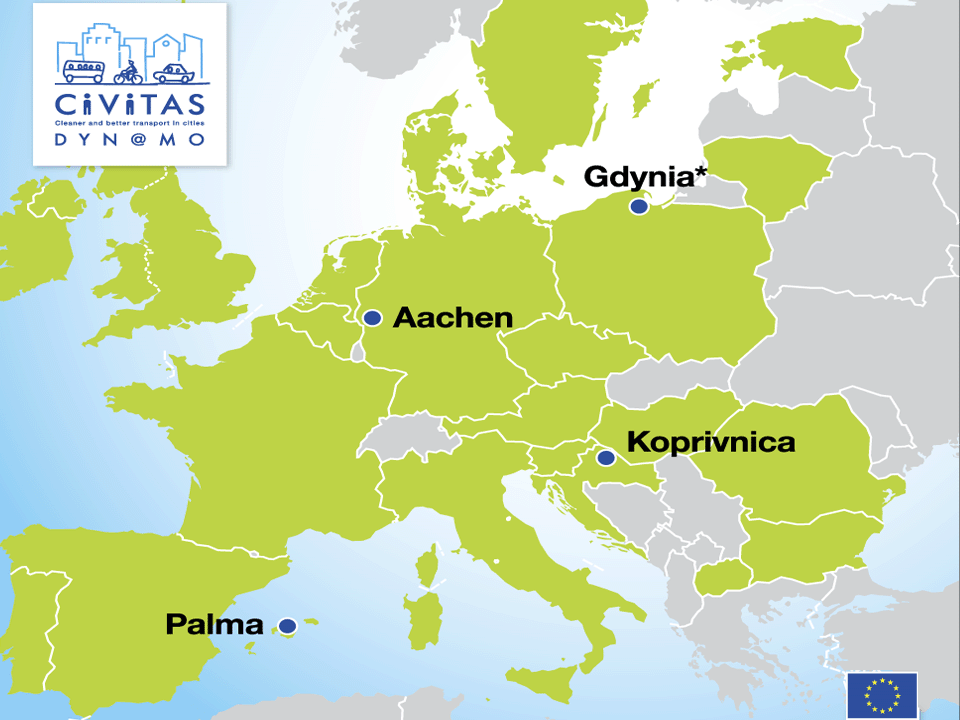
|
|
CIVITAS DYN@MO in a nutshell
CIVITAS DYN@MO is an ambitious project bringing together four European cities that have agreed on a mission to strengthen sustainable mobility. DYN@MO is short for the project motto DYNamic citizens @ctive for sustainable MObility.
The participating cities are Aachen (DE), Gdynia (PL), Palma de Mallorca (ES) and Koprivnica (HR).
The cities will promote non-polluting lifestyles, col- laborate with citizens with new, web-based tools, and implement integrated, innovative transport services for
active citizens of all ages.
The project consortium consists of 28 partners in the participating cities, supported by the Union of the Baltic Cities, Rupprecht Consult and Lund University.
CIVITAS DYN@MO is part of the CIVITAS Initiative, supporting cities to introduce ambitious transport measures and policies towards sustainable urban
mobility. The project runs until November 2016.
|
|
|
|
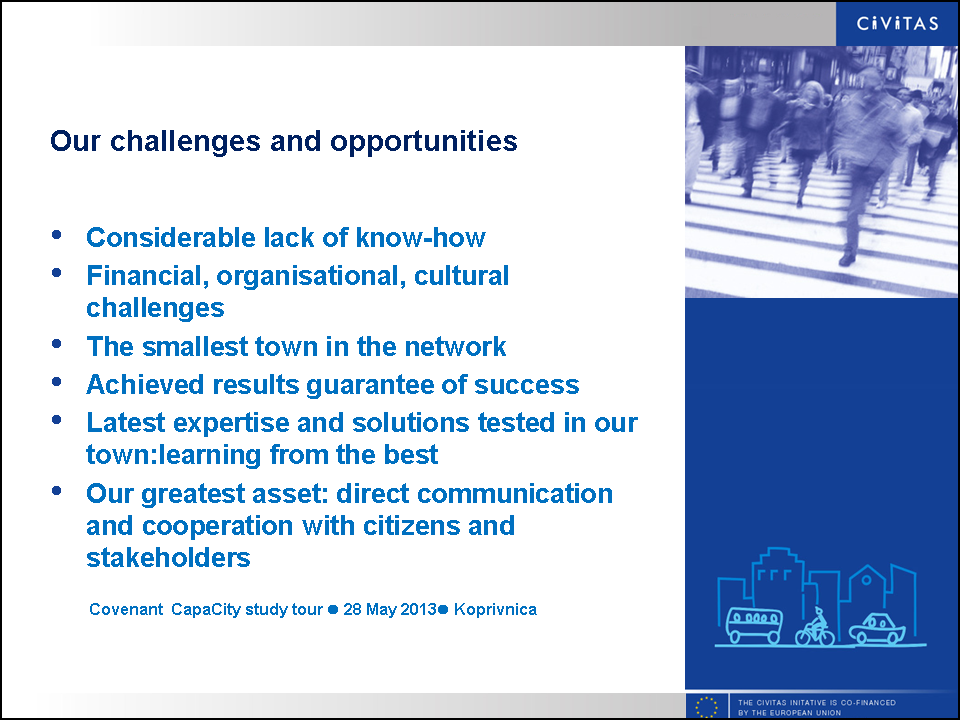
|
|
CIVITAS DYN@MO objectives
The strategic aims of CIVITAS-DYN@MO are threefold.
The project will:
- Develop “Mobility 2.0” systems and services by
applying new web-based technologies;
- Implement innovative electric mobility solutions,
using new electric and hybrid vehicles and
- Engage in a dynamic citizen dialogue for mobility
planning and service improvement.
At the strategic level, CIVITAS DYN@MO cities will
create a culture for interactive mobility planning in
which citizens and other stakeholders can actively
participate in planning through dynamic processes.
At the technical level, CIVITAS DYN@MO cities will use clean, energy-efficient vehicles, especially electric vehicles, and advanced ICT and ITS Systems as the basis of innovative transport services.
At the service level, citizens and travellers in the CIVITAS DYN@MO cities will experience innovation hotspots with exciting new mobility services.
|
|
|
|
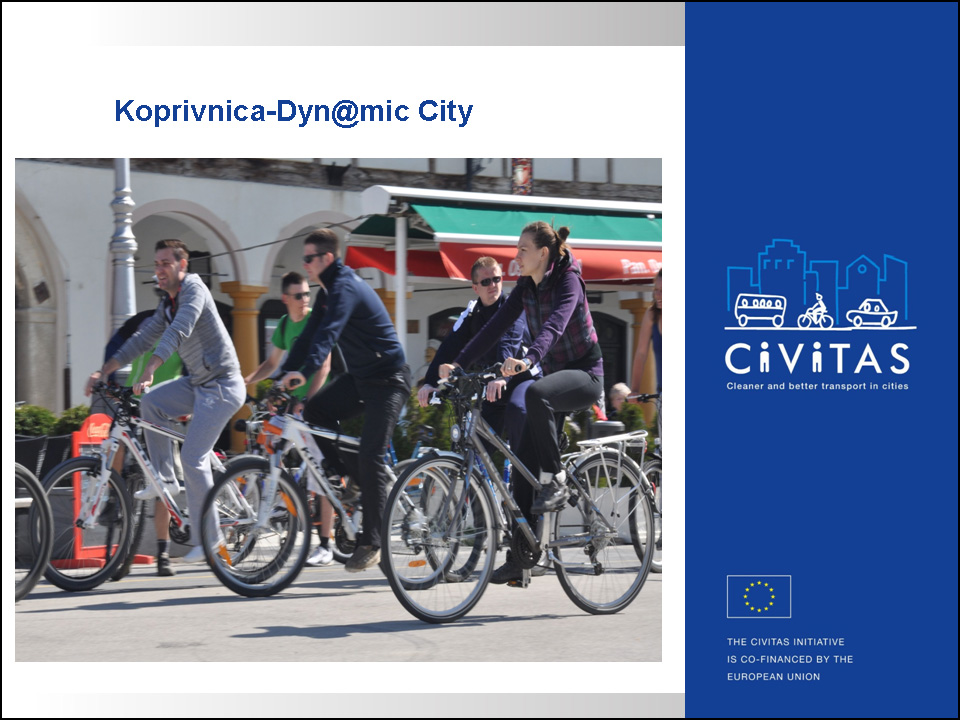
|
|
CIVITAS DYN@MO in action: Implementing sustainable mobility
The four DYN@MO cities will implement altogether 30
innovative measures within three working areas:
Engaging in a dynamic citizen dialogue
- Sustainable Urban Mobility Plans (SUMP)
Sustainable Urban Mobility Plans are at the core of
the project and give a sound basis for mobility planning.
The two leading cities, Aachen and Gdynia, will
advance their planning culture and existing SUMPs
while Koprivnica and Palma develop ambitious SUMPs
– all including extensive citizen and stakeholder
involvement via
|
|
|
|
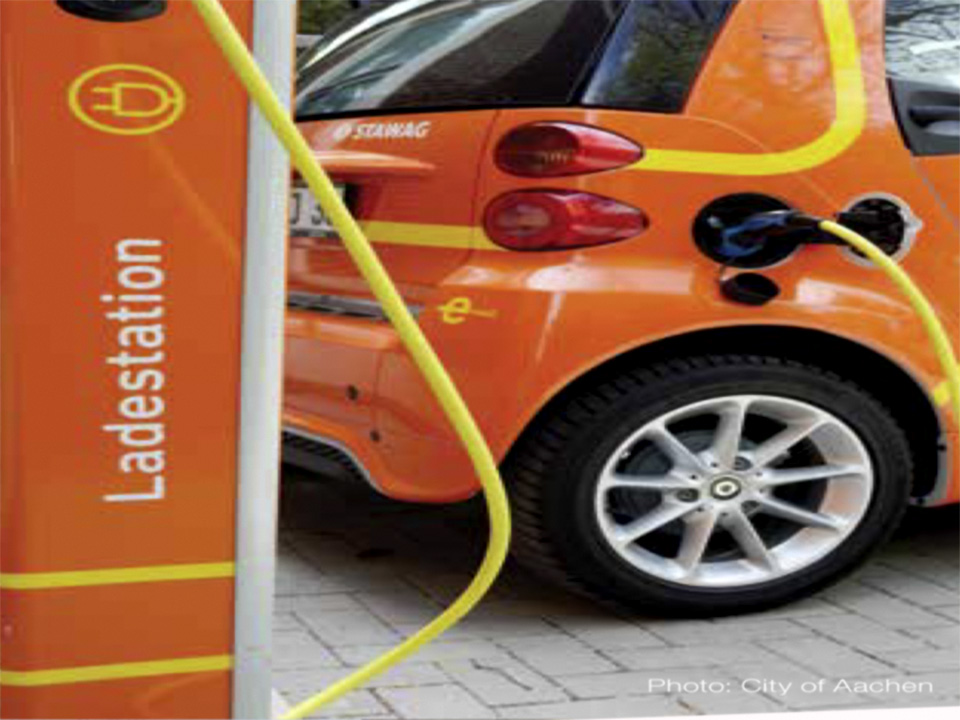
|
|
Implementing city and citizen-friendly electric mobility solutions
- Clean and energy efficient vehicles
The DYN@MO cities are strongly committed to make
their public transport cleaner and to enhance the
environmental performance and energy efficiency
of their fleets. Besides acquiring new, more environmentally
friendly vehicles for public transport and the
municipal fleet, the cities will test and promote other
electric vehicles and modes of sustainable transport
with pilot projects.
|
|
|
|
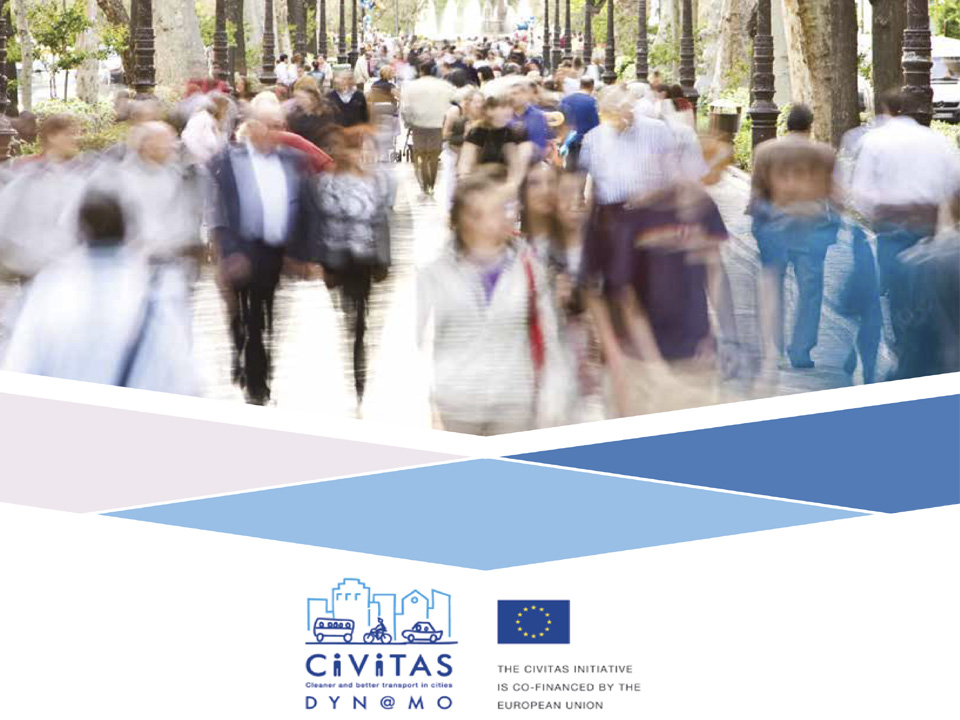
|
|
Developing “Mobility 2.0” systems and services
- Use of Information and Communication Technology
(ICT) and Intelligent Transport Systems (ITS)
Throughout the project, “Mobility 2.0” systems and
services will be developed by applying web-based
technologies. The new systems and services will
improve the service quality of public transport as well
as the communication and maintenance of transport
systems. New services will also support the preparations
for developing or updating SUMPs and provide
new ways of involving citizens and stakeholders in the
SUMP process.
The project also works at the European level. All 30
measures implemented in the four DYN@MO cities
will have a high degree of transferability across
Europe. The decision makers and technical experts
from DYN@MO cities will actively contribute to European
exchange through annual summer universities,
trainings and by establishing competence centres
for Sustainable Urban Mobility Planning (SUMP) and
electromobility.
|
|
|